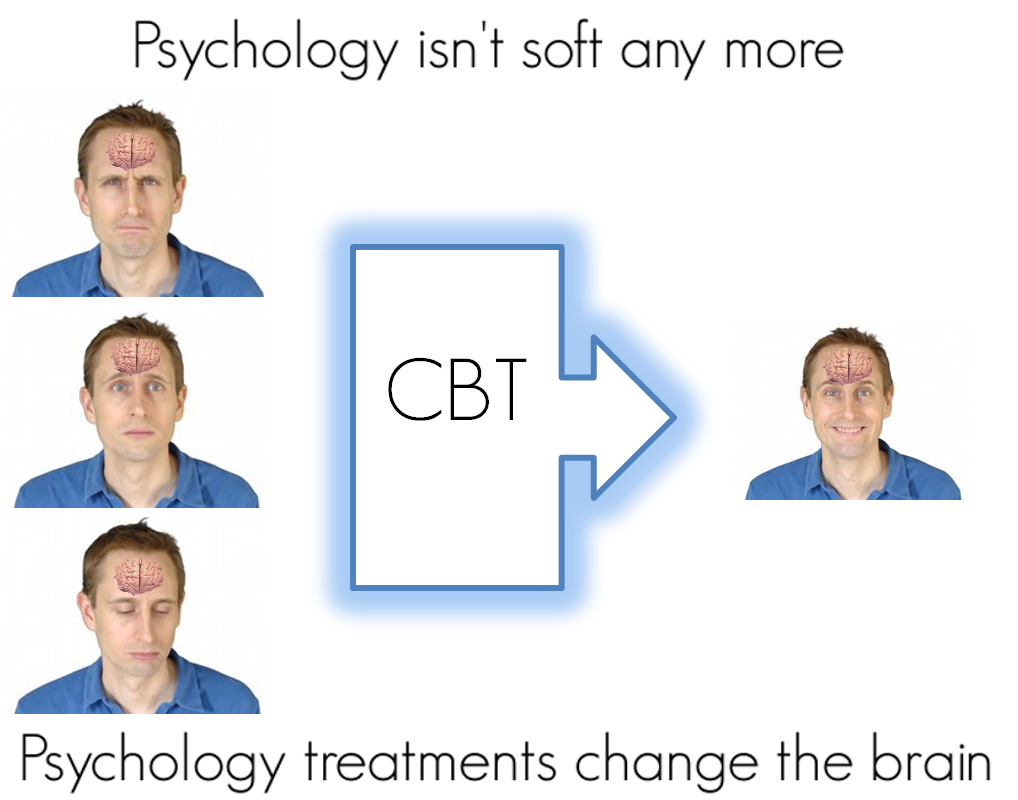There is a well known 2011 study that looks at the brains of London taxi drivers. The map of London is complex, and taxi drivers are required to memorize the complete layout and pass a difficult exam before being given their taxi license. The study found that the hippocampus region of the brain, which plays an important role in memory, actually grows (in a physical sense) while the prospective drivers are studying for the exam. This is an interesting result since it clearly shows that our actions can make real, measurable changes to our brains.
Can you change your brain with therapy?
In short, yes.
Some people view psychological treatments as “softer” than using medication, since drugs can directly target neurochemical aspects of the brain. However, this view is unjustified, since there is mounting evidence that therapy can make very real structural changes to the brain. A great example is CBT.
Cognitive behavior therapy (CBT) is an evidence-based approach to tackling mental health problems, such as anxiety or depression. CBT has been subject to countless clinical trials, and has even been shown to be more effective than medication in some long-term studies. CBT works by targeting the thoughts and behaviours that are maintaining the problem (more information about CBT, and how it can be administered online, can be found here). For example, consider someone who has social anxiety and would like to ask their boss for a raise or promotion. This would be extremely stressful situation for them, and they would likely put it off indefinitely. CBT treatment would examine the thoughts that are leading to this avoidance, and would challenge them through a series of exercises. In much the same way that physical exercise changes the body, these mental exercises can make changes to the structure of your brain!
How does CBT change the brain?
The fact that CBT changes the brain is not a particularly new result. However, neuroscience journals tend to announce findings with headlines like “The neurobiological role of the dorsolateral prefrontal cortex in…”. The details are complex, but the general idea is understandable in surprisingly basic terms.
The brain is divided into different regions or modules, each of which is specialized to perform a certain type of task. For example, the visual cortex is the region of the brain that processes the sensory input from the eyes. There are some brain structures that deal with emotions such as stress and fear, and collectively these are sometimes known as the “emotional brain”. These are very “old” areas of the brain, in the sense that we share them with our distant ancestors. When a socially anxious person is nervous when thinking about asking for a raise, it is the emotional brain that is becoming active.
There are higher order brain structures that deal with planning, logic and reasoning. These are sometimes known as the “logical brain”. These brain areas, such as the prefrontal cortex, are “newer” in the sense that they are much larger in primates than in other species. There are two key points:
- The logical brain is able to override the emotional brain. For example, our socially anxious person can take a rational look at the situation, and realize that he or she is exaggerating the potential risks. He or she might come to the conclusion “the worst case scenario is that the boss says no – that’s not the end of the world!” This thought will help them calm down, and build the confidence to actually ask for the raise.
– - Every time the logical brain overrides the emotional brain, the logical brain “muscle” becomes stronger and stronger. In other words, through CBT training the brain actually reinforces the neural pathways, so it becomes easier and easier to deal with future stressful situations.
This is good news: by changing our thinking and behaviour using CBT, we are making positive, long term, hard coded changes to our brains!

Fjola Helgadottir, PhD, MClinPsych, is a clinical psychologist, a senior research clinician at the University of Oxford, and is a co-creator of AI-Therapy.com, an online CBT treatment program for overcoming social anxiety
